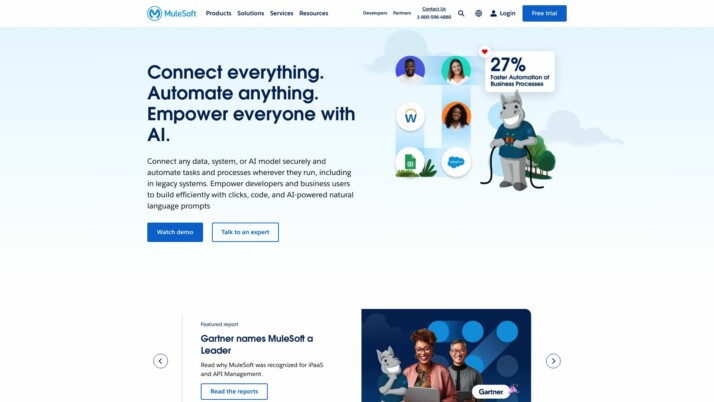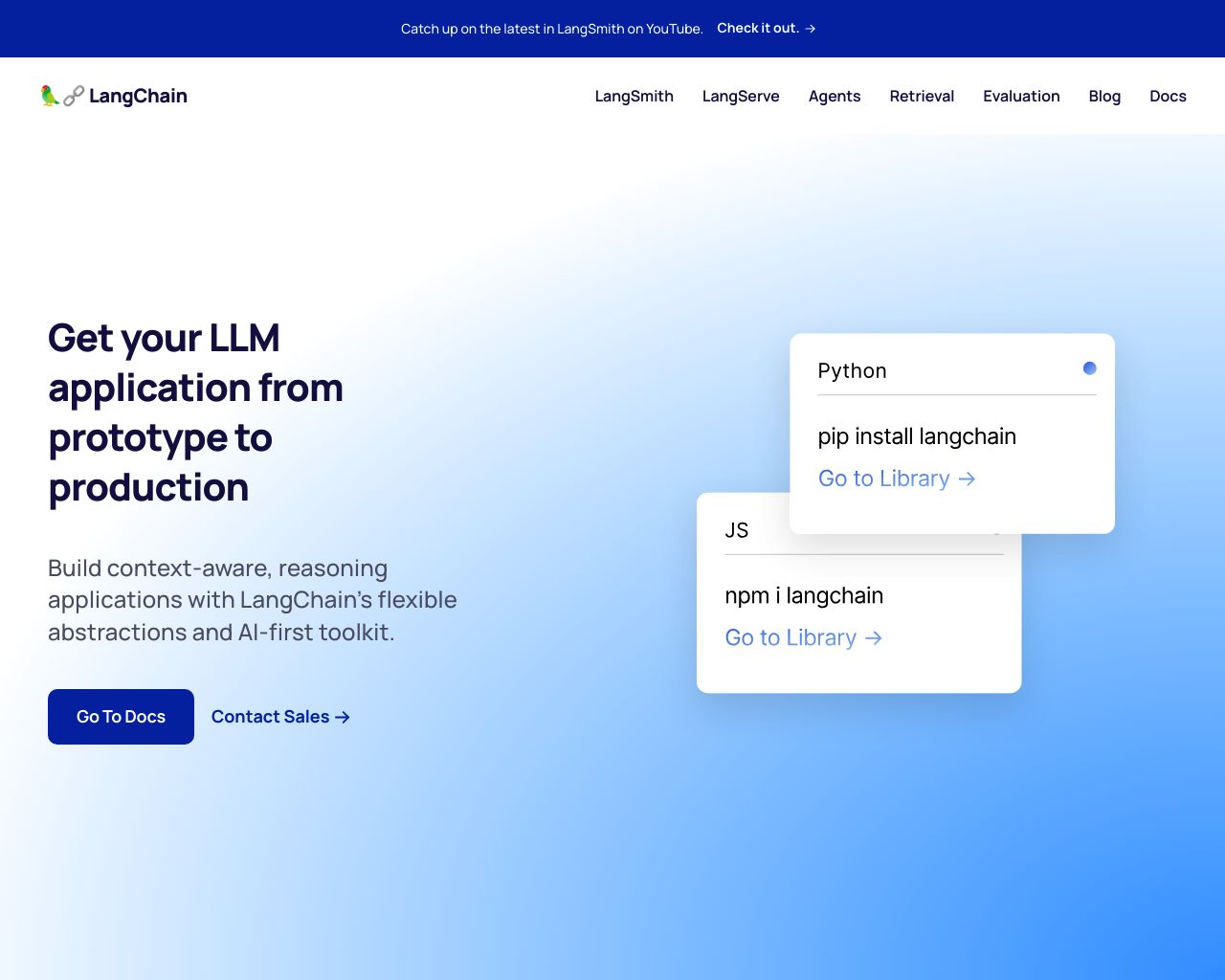The AI landscape teems with powerful tools, each promising to revolutionize how businesses harness machine learning. This review cuts through the hype, comparing Mulesoft’s enterprise integration prowess, LangChain’s LLM application development framework, and SmythOS’s user-friendly AI platform. We’ll dissect core features, security measures, and development approaches to help you navigate these options.
Whether you’re a seasoned developer, a business leader, or an AI enthusiast, you’ll gain insights into how each platform tackles AI integration, application building, and deployment. By the end, you’ll understand which solution best fits your organization’s needs for creating sophisticated, secure, and scalable AI-driven applications.
Mulesoft Overview
Mulesoft revolutionizes enterprise connectivity and automation with its comprehensive integration platform. The Anypoint Platform empowers organizations to design, build, and manage APIs, enabling seamless data exchange across diverse systems. Mulesoft’s API-led approach promotes solution reusability, enhancing efficiency and security in digital interactions.

Mulesoft revolutionizes enterprise connectivity and automation with its comprehensive integration platform. The Anypoint Platform empowers organizations to design, build, and manage APIs…
Mulesoft excels in AI integration, connecting data silos to drive personalized experiences across business functions. The platform’s Integration and Automation for AI capabilities enhance AI outputs, facilitating more intelligent decision-making processes. Mulesoft’s Anypoint Code Builder, powered by Einstein AI, accelerates project initiation through natural language prompts, significantly boosting developer productivity.
Security and governance stand out as Mulesoft strengths. The Anypoint Flex Gateway and API Governance features ensure controlled API management, critical for safeguarding AI and data integrations. These robust security measures position Mulesoft as a leader in secure enterprise integration solutions.
Mulesoft’s vision centers on empowering organizations with potent integration and automation capabilities, leveraging AI to create efficient, secure, and adaptive business processes. The platform aims to facilitate real-time, data-driven decision-making and personalized customer experiences by seamlessly integrating AI across all business functions.
Mulesoft’s vision centers on empowering organizations with potent integration and automation capabilities, leveraging AI to create efficient, secure, and adaptive business processes.
While Mulesoft offers extensive capabilities, its complex feature set may present a learning curve for some users. Additionally, the platform’s enterprise focus might make it less suitable for smaller organizations with limited integration needs or budget constraints. Despite these considerations, Mulesoft’s comprehensive approach to integration and AI automation positions it as a formidable player in the enterprise integration space.
LangChain Overview
LangChain revolutionizes the development of large language model (LLM) applications. This open-source framework simplifies every stage of the LLM application lifecycle, from initial development to final deployment. LangChain offers a comprehensive suite of tools designed to empower developers in creating sophisticated AI-driven solutions.

At its core, LangChain provides modular building blocks and integrations that streamline the creation of LLM applications. The framework includes LangGraph for building stateful agents, LangSmith for monitoring and evaluation, and LangServe for deploying chains as APIs. These components work together to offer a robust ecosystem for AI development.
LangChain’s standout feature is its Expression Language (LCEL), which allows for declarative chaining of components. This approach enables first-class streaming support, optimized parallel execution, and seamless tracing.
LangChain’s standout feature is its Expression Language (LCEL), which allows for declarative chaining of components. This approach enables first-class streaming support, optimized parallel execution, and seamless tracing. The framework also boasts a Runnable interface, providing a standard way to create custom chains with methods like stream, invoke, and batch.
While LangChain offers powerful capabilities, it may present a steeper learning curve for beginners compared to some alternatives. The open-source nature of the framework means that users may need to invest more time in configuration and setup. Additionally, as with any rapidly evolving technology, keeping up with updates and changes can be challenging.
Despite these considerations, LangChain’s comprehensive approach to LLM application development makes it a compelling choice for developers looking to push the boundaries of AI integration in their projects. Its modular design and extensive toolkit position it as a versatile solution for a wide range of AI-driven applications.
Feature Comparison
Mulesoft and LangChain offer distinct approaches to AI integration and development, with notable differences in their core components and security features. Mulesoft excels in enterprise-grade integration, providing robust API management and security controls through its Anypoint Platform. Its Anypoint Flex Gateway and API Governance features ensure tightly controlled API usage, critical for organizations handling sensitive data. LangChain, on the other hand, focuses on simplifying the development of large language model (LLM) applications, offering modular building blocks and integrations specifically tailored for AI development.
In terms of core components, Mulesoft’s strength lies in its comprehensive integration capabilities, connecting diverse systems and data sources across an organization. It supports a wide range of APIs and robotic process automation (RPA) integrations, making it ideal for complex enterprise environments. LangChain, while also supporting various integrations, specializes in components designed for LLM applications, such as prompt templates, output parsers, and retrieval augmented generation (RAG). This focus makes LangChain particularly suited for developers working directly with AI models and natural language processing tasks.
Security features present another area of divergence. Mulesoft’s enterprise focus is evident in its robust security measures, including detailed API policies, monitoring, and IP whitelisting capabilities. LangChain, while offering security features, may require additional configuration or third-party tools to match Mulesoft’s enterprise-grade security standards. However, LangChain’s open-source nature allows for greater customization and community-driven security enhancements, which may appeal to developers seeking more control over their AI application’s security implementation.
Feature Comparison Table
| Mulesoft | LangChain | SmythOS | |
|---|---|---|---|
| CORE FEATURES | |||
| Visual Builder | ✅ | ❌ | ✅ |
| No-Code Options | ✅ | ❌ | ✅ |
| Memory & Context | ❌ | ✅ | ✅ |
| Explainability & Transparency | ❌ | ✅ | ✅ |
| Problem-Solving Capabilities | ❌ | ✅ | ✅ |
| Human-AI Interaction | ❌ | ✅ | ✅ |
| Audit Logs for Analytics | ❌ | ✅ | ✅ |
| Agent Work Scheduler | ✅ | ❌ | ✅ |
| SECURITY | |||
| Constrained Alignment | ✅ | ❌ | ✅ |
| Data Encryption | ❌ | ✅ | ✅ |
| IP Control | ✅ | ❌ | ✅ |
| COMPONENTS | |||
| Huggingface AIs | ❌ | ✅ | ✅ |
| Zapier APIs | ❌ | ❌ | ✅ |
| All other APIs, RPA | ❌ | ✅ | ✅ |
| Logic | ❌ | ✅ | ✅ |
| Data Lakes | ✅ | ❌ | ✅ |
| DEPLOYMENT OPTIONS (EMBODIMENTS) | |||
| Deploy as Webhook | ✅ | ❌ | ✅ |
| Staging Domains | ✅ | ❌ | ✅ |
| Production Domains | ✅ | ❌ | ✅ |
| Deploy as Scheduled Agent | ❌ | ❌ | ✅ |
| Scalability | ❌ | ✅ | ✅ |
| DATA LAKE SUPPORT | |||
| Hosted Vector Database | ✅ | ❌ | ✅ |
| Sitemap Crawler | ❌ | ❌ | ✅ |
| YouTube Transcript Crawler | ❌ | ❌ | ✅ |
| URL Crawler | ❌ | ❌ | ✅ |
| PDF Support | ❌ | ✅ | ✅ |
| Word File Support | ✅ | ❌ | ✅ |
Best Alternative to Mulesoft and LangChain
SmythOS emerges as the superior alternative to Mulesoft and LangChain, offering a comprehensive agentic AI automation platform that combines the best of both worlds. Our platform excels in ease of use, feature richness, and unlimited use cases, making it the ideal choice for businesses seeking powerful AI solutions.
SmythOS’s intuitive drag-and-drop interface simplifies the creation of complex AI workflows, eliminating the need for extensive coding knowledge. This visual approach democratizes AI development, allowing users to focus on innovation rather than technical implementation. In contrast, Mulesoft and LangChain often require more specialized expertise, limiting their accessibility to a broader audience.
SmythOS’s intuitive drag-and-drop interface simplifies the creation of complex AI workflows, eliminating the need for extensive coding knowledge.
We offer an unparalleled feature set that surpasses both Mulesoft and LangChain. SmythOS provides robust support for autonomous agents, multi-agent collaboration, and human-AI interaction. Our platform includes advanced capabilities such as memory and context management, explainability, and problem-solving capabilities that are either limited or absent in Mulesoft and LangChain. These features enable the development of sophisticated AI solutions that can tackle complex tasks across various industries.
SmythOS’s versatility sets it apart from its competitors. While Mulesoft excels in enterprise integration and LangChain focuses on language model applications, SmythOS offers a unified platform that caters to a wide range of use cases. From chatbots and virtual assistants to complex data analysis and decision-making systems, our platform adapts to diverse business needs without compromising on performance or scalability.
Security and deployment options further distinguish SmythOS from Mulesoft and LangChain. We provide enterprise-grade security features, including data encryption and IP control, ensuring that your AI solutions meet the highest standards of data protection. Our platform also offers flexible deployment options, allowing you to easily integrate AI agents into existing systems or deploy them as standalone applications, APIs, or scheduled tasks.
SmythOS offers a unified platform that caters to a wide range of use cases… without compromising on performance or scalability.
By choosing SmythOS, you’re not just selecting an AI platform; you’re empowering your organization with a cutting-edge solution that combines ease of use, comprehensive features, and unlimited potential. Our platform delivers the tools you need to stay ahead in the rapidly evolving world of AI, making it the clear choice over Mulesoft and LangChain for businesses looking to harness the full power of artificial intelligence.
Conclusion
Mulesoft and LangChain offer powerful solutions for enterprise integration and AI development respectively, but SmythOS emerges as the superior choice for businesses seeking a comprehensive, user-friendly AI platform.
Mulesoft excels in enterprise-grade integration and API management, making it suitable for large organizations with complex data ecosystems. Its robust security features and Einstein AI integration provide significant value for enterprises prioritizing controlled API usage and AI-enhanced productivity. However, Mulesoft’s complexity may pose challenges for smaller teams or those new to integration platforms.
LangChain shines in the LLM application development space, offering modular components and tools tailored for AI developers. Its open-source nature and specialized features like LangGraph and LangSmith appeal to those deeply involved in AI model implementation. Yet, LangChain may require more technical expertise and additional configuration for enterprise-level security and deployment.
SmythOS stands out by combining the strengths of both platforms while addressing their limitations. Our drag-and-drop interface democratizes AI development, allowing users to create sophisticated AI agents without extensive coding knowledge. With over 300,000 integrations, SmythOS offers unparalleled flexibility in connecting to various data sources, APIs, and AI models. Our ’Create Once, Deploy Anywhere’ approach ensures seamless integration across multiple platforms, from chatbots to APIs.
We invite you to experience the power of SmythOS firsthand. Create a free SmythOS account today and start building AI agents with our intuitive platform. For those looking to jumpstart their projects, explore our diverse range of AI-powered agent templates. Transform your workflow and unlock the full potential of AI with SmythOS – where innovation meets simplicity.